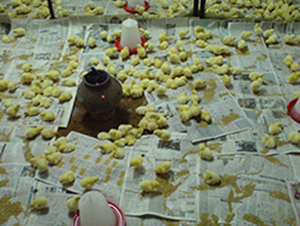Introduction:
- Equipment used to provide warmth and light and to rear the baby chicks during the first few weeks of life are called brooders.
- The brooders consist of some heating source, reflectors to reflect the heat and light towards the chicks, light and heat adjustment devices such as stands, thermostats and other accessories, depending on the model.
- Different equipment used for brooding are,
Charcoal or kerosene stove
- These are used in places where electricity is not available or costly and where power failure is quite common.
- These stoves are covered with plates or pans to sustain the heat in the brooding area.
Hovers
- These are reflectors of heat and light
- Flat type hovers
- These are flat in nature in which electrical bulbs are fitted.
- Generally they are mounted with stands on all four corners, instead of hanging from the roof.
- Canopy type hovers
- This mechanism and thermometer.
Infra-Red bulbs / self-reflecting bulbs
- In general, IR bulbs are self reflecting bulbs and hence no need of reflector over the bulbs.
- 150 and 250 watt bulbs are available to provide sufficient heat to 150 and 250 chicks, respectively.
Brooder guards / Chick guards
- These are thin sheets of metal, hard board, or bamboo mat of 1 to 1.5 feet height and varying in lengths.
- They are used to restrict the movement of chicks, so that the chicks will be kept closer to the brooders and prevent them from chilling.
Gas brooder
- In this heating element is connected with natural gas.
- They are usually hanged 3-5’ above the chick level to provide heat.
- It is attached with canopy type reflectors to reflect the heat towards the chicks.
Electrical heaters (heating rods or coils)
- This type of brooder is provided with heating elements and pilot lamps and in some cases thermometer is provided to record the temperature.
- They used to have a reflecting device over the heating rods or coils.
- The temperature can be adjusted depending on the requirement.
|
 |